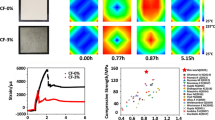Abstract
A collection of applications of polymer matrix syntactic foams is presented in this article. Syntactic foams are lightweight porous composites that found their early applications in marine structures due to their naturally buoyant behavior and low moisture absorption. Their light weight has been beneficial in weight sensitive aerospace structures. Syntactic foams have pushed the performance boundaries for composites and have enabled the development of vehicles for traveling to the deepest parts of the ocean and to other planets. The high volume fraction of porosity in syntactic foams also enabled their applications in thermal insulation of pipelines in oil and gas industry. The possibility of tailoring the mechanical and thermal properties of syntactic foams through a combination of material selection, hollow particle volume fraction, and hollow particle wall thickness has helped in rapidly growing these applications. The low coefficient of thermal expansion and dimensional stability at high temperatures are now leading their use in electronic packaging, composite tooling, and thermoforming plug assists. Methods have been developed to tailor the mechanical and thermal properties of syntactic foams independent of each other over a wide range, which is a significant advantage over other traditional particulate and fibrous composites.
















Similar content being viewed by others
References
B.H. Rutz and J.C. Berg, Adv. Colloid Interface Sci. 160, 56 (2012).
G. Hu and D. Yu, Mater. Sci. Eng. A 528, 5177 (2011).
N. Gupta, E. Woldesenbet, R.S. Kishore, and S. Sankaran, J. Mater. Sci. 36, 4485 (2001).
S.R. Kishore and S. Sankaran, Mater. Sci. Eng. A 412, 153 (2005).
L. Zhang and J. Ma, Mater. Sci. Eng. A 574, 191 (2013).
M. Porfiri and N. Gupta, Compos. B Eng. 40, 166 (2009).
S.R. Kishore and S. Sankaran, J. Mater. Sci. 41, 7459 (2006).
R.S. Kishore and S. Sankaran, J. Appl. Polym. Sci. 98, 673 (2005).
R.S. Kishore and S. Sankaran, J. Appl. Polym. Sci. 98, 680 (2005).
N. Gupta and V.C. Shunmugasamy, Mater. Sci. Eng. A 528, 7596 (2011).
M. Porfiri, N. Nguyen, and N. Gupta, J. Mater. Sci. 44, 1540 (2009).
V.C. Shunmugasamy, D. Pinisetty, and N. Gupta, J. Mater. Sci. 47, 5596 (2012).
V. Shabde, K. Hoo, and G.M. Gladysz, J. Mater. Sci. 41, 4061 (2006).
N. Gupta, S. Priya, R. Islam, and W. Ricci, Ferroelectrics 345, 1 (2006).
V.C. Shunmugasamy, D. Pinisetty, and N. Gupta, J. Mater. Sci. accepted fpr publication (2013), doi: 10.1007/s10853-013-7691-0
K.C. Yung, B.L. Zhu, T.M. Yue, and C.S. Xie, Compos. Sci. Technol. 69, 260 (2009).
V.C. Shunmugasamy, N. Gupta, N.Q. Nguyen, and P.G. Coelho, Mater. Sci. Eng. A 527, 6166 (2010).
N. Gupta, D. Pinisetty, and V.C. Shunmugasamy, Reinforced Polymer Matrix Syntactic Foams: Effect of Nano and Micro-Scale Reinforcement (New York: Springer, 2013).
B. John and C.P. Reghunadhan Nair, Update on Syntactic Foams (Shropshire: Smithers Rapra Technology, 2010).
N. Gupta, E. Woldesenbet, and P. Mensah, Compos. A Appl. Sci. Manuf. 35, 103 (2004).
L. Bardella, A. Sfreddo, C. Ventura, M. Porfiri, and N. Gupta, Mech. Mater. 50, 53 (2012).
National Oceanic and Atmospheric Administration, http://oceanexplorer.noaa.gov/technology/subs/alvin/alvin.html. Accessed 7 Oct 2013.
R.L. Poveda, G. Dorogokupets, and N. Gupta, Polym. Degrad. Stab. 98, 2041 (2012).
http://en.wikipedia.org/wiki/File:USS_Memphis_(SSN-691).jpg. Accessed 7 Oct 2013.
http://en.wikipedia.org/wiki/File:Zumwalt_Deckplate_Transit.jpg. Accessed 7 Oct 2013.
http://en.wikipedia.org/wiki/File:FA-18_Hornet_VFA-41.jpg. Accessed 7 Oct 2013.
M.Y. Chen, L.E. Matson, H. Lee, and C. Chen, SPIE Proc., Optic. Mater. Struct. Technol. IV (Bellingham, WA: SPIE, 2009), p. 74250S- 1-9.
L.E. Matson and D.H. Mollenhauer, AMPTIAC Q. 8, 67 (2004).
S.D. Vining and P.J. Hood, SPIE Proceedings, UV/Optical/IR Space Telescopes: Innovative Technologies and Concepts, ed. H.A. MacEwen (Bellingham, WA: SPIE, 2004).
R.L. Van Auken, U.S. patent 4,065,150 A (1977).
G.W. Filice and E.H. Hoyt, Jr., U.S. patent 4,819,608A (1989).
T.E. Cravens, J. Cell. Plast. 9, 260 (1973).
D.W. Green, J.E. Winandy, and D.E. Kretschmann, Wood Handbook: Wood as an Engineering Material (Madison, WI: Forest Products Laboratory, 1999), pp. 1–45.
T.F. Anderson, H.A. Walters, and C.W. Glesner, J. Cell. Plast. 6, 171 (1970).
H. Mohammad and S. Kunigal, Paper presented at the 51st AIAA/ASME/ASCE/AHS/ASC Structures, Structural Dynamics, and Materials Conference, Orlando, FL, 12–15 April 2010.
Acknowledgments
This work is supported by Office of Naval Research grant N00014-10-1-0988 with Dr. Yapa D.S. Rajapakse as the program manager. The authors thank 3M Co. and Oliver M. Strbik III of Deep Springs Technologies (Toledo, OH) for providing glass and SiC hollow particles, respectively, for imaging. Useful discussions with Dr. Gary Galdysz are acknowledged. James Cameron and Ron Allum are thanked for providing images of Deepsea Challenger. Peter Russell of Flotation Technologies, William Ricci and Ruth Clay of Trelleborg Offshore (Boston, MA), and Jeff Barker of Tooling Technologies LLC (Fort Loramie, OH) are thanked for providing images as indicated in the captions. Dr. Dung D. Luong provided the three-dimensional solid model images of syntactic foams.
Disclaimer
Reference herein to any specific commercial company, product, process, or service by trade name, trademark, manufacturer, or otherwise, does not necessarily constitute or imply its endorsement, recommendation, or favoring by the United States Government, ONR or the authors. The opinions of the authors expressed herein do not necessarily state or reflect those of the United States Government or the ONR, and shall not be used for advertising or product endorsement purposes.
Author information
Authors and Affiliations
Corresponding author
Rights and permissions
About this article
Cite this article
Gupta, N., Zeltmann, S.E., Shunmugasamy, V.C. et al. Applications of Polymer Matrix Syntactic Foams. JOM 66, 245–254 (2014). https://doi.org/10.1007/s11837-013-0796-8
Received:
Accepted:
Published:
Issue Date:
DOI: https://doi.org/10.1007/s11837-013-0796-8




